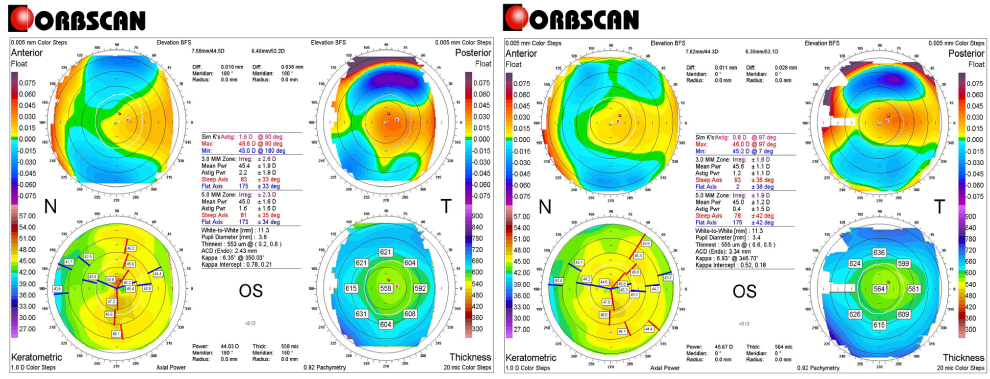Korean J Ophthalmol.
2010 Apr;24(2):78-82. 10.3341/kjo.2010.24.2.78.
The Short Term Effects of a Single Limbal Relaxing Incision Combined with Clear Corneal Incision
- Affiliations
-
- 1Department of Ophthalmology, Seoul National University College of Medicine, Seoul, Korea. smk9@snu.ac.kr
- 2Seoul Artificial Eye Center, Seoul National University Hospital Clinical Research Institute, Seoul, Korea.
- 3Department of Ophthalmology, Seoul National University Bundang Hospital, Seongnam, Korea.
- KMID: 945998
- DOI: http://doi.org/10.3341/kjo.2010.24.2.78
Abstract
- PURPOSE
To compare the effects of performing a single limbal relaxing incision (LRI) combined with a clear corneal incision on a corneal astigmatism with that of paired LRIs in cataract surgery. METHODS: Medical records for 25 eyes in 20 patients who had undergone LRIs during cataract operations for with-the-rule astigmatism of 1.5 diopters (D) or more in topography were retrospectively reviewed. Single or paired LRIs were assigned randomly and were performed on the steepest axis; the degrees of arc were determined using the modified Gills nomogram. A clear corneal wound was made on the steepest vertical axis. Uncorrected visual acuity (UCVA), best corrected visual acuity (BCVA), manifest refraction, and corneal astigmatism on topography were evaluated preoperatively and one month postoperatively. Naeser's polar value analysis was used to assess the efficacy of the LRIs. RESULTS: The mean depth of the LRIs and degrees of arc were 620+/-31 micrometer (87.1% of corneal thickness) and 56.84+/-19.68degrees, respectively. The mean postoperative UCVA and BCVA (log MAR) were significantly improved (0.51+/-0.37 and 0.09+/-0.12, respectively) (p<0.05). Average refractive and corneal astigmatisms were significantly reduced by 49.4 percent and 32.4 percent, respectively (p<0.05). The single LRI combined with clear corneal incision showed reduced efficacy in refractive astigmatism by 47 percent, which is similar to that of paired LRIs where a 48 percent reduction in efficacy was seen. CONCLUSIONS: The short-term effects of a single LRI combined with clear corneal incision on a corneal astigmatism appears to be as effective as performing paired LRIs when combined with cataract incision.
MeSH Terms
Figure
Cited by 1 articles
-
Effect of Toric Intraocular Lens Implantation on Astigmatism in Cataract Surgery
Yong Jae Cha, Mee Kum Kim, Won Ryang Wee
J Korean Ophthalmol Soc. 2015;56(10):1544-1551. doi: 10.3341/jkos.2015.56.10.1544.
Reference
-
1. Budak K, Friedman NJ, Koch DD. Limbal relaxing incisions with cataract surgery. J Cataract Refract Surg. 1998. 24:503–508.2. Müller-Jensen K, Fischer P, Siepe U. Limbal relaxing incisions to correct astigmatism in clear corneal cataract surgery. J Refract Surg. 1999. 15:586–589.3. Gills JP, Gayton JL. Gills JP, Fenzl R, Martin RG, editors. Reducing pre-existing astigmatism. Cataract surgery: the state of the art. 1998. Thorofare (NJ): Slack;53–66.4. Nichamin LD. Astigmatism control. Ophthalmol Clin North Am. 2006. 19:485–493.5. Kaufmann C, Peter J, Ooi K, et al. Limbal relaxing incisions versus on-axis incisions to reduce corneal astigmatism at the time of cataract surgery. J Cataract Refract Surg. 2005. 31:2261–2265.6. Langerman DW. Architectural design of a self-sealing corneal tunnel, single-hinge incision. J Cataract Refract Surg. 1994. 20:84–88.7. Naeser K, Behrens JK, Naeser EV. Quantitative assessment of corneal astigmatic surgery: expanding the polar values concept. J Cataract Refract Surg. 1994. 20:162–168.8. Argento C, Mendy JF, Cosentino MJ. Laser in situ keratomileusis versus arcuate keratotomy to treat astigmatism. J Cataract Refract Surg. 1999. 25:374–382.9. Cherry PM. Treatment of astigmatism associated with myopia or hyperopia with the holmium laser: second year follow-up. Ophthalmic Surg Lasers. 1996. 27:S493–S498.10. Condon PI, Mulhern M, Fulcher T, et al. Laser intrastromal keratomileusis for high myopia and myopic astigmatism. Br J Ophthalmol. 1997. 81:199–206.11. Kremer FB, Dufek M. Excimer laser in situ keratomileusis. J Refract Surg. 1995. 11:S244–S247.12. Agapitos PJ, Lindstrom RL, Williams PA, Sanders DR. Analysis of astigmatic keratotomy. J Cataract Refract Surg. 1989. 15:13–18.13. Güell JL, Vazquez M. Correction of high astigmatism with astigmatic keratotomy combined with laser in situ keratomileusis. J Cataract Refract Surg. 2000. 26:960–966.14. Ganem S, Sidhoum SB. Surgery in myopic astigmatism: arciform keratotomy and PKR versus PARK. Bull Soc Belge Ophtalmol. 1997. 266:87–90.15. Budak K, Yılmaz G, Aslan BS, Duman S. Limbal relaxing incisions in congenital astigmatism: 6 month follow-up. J Cataract Refract Surg. 2001. 27:715–719.16. Bayramlar HH, Dağlioğlu MC, Borazan M. Limbal relaxing incisions for primary mixed astigmatism and mixed astigmatism after cataract surgery. J Cataract Refract Surg. 2003. 29:723–728.17. Carvalho MJ, Suzuki SH, Freitas LL, et al. Limbal relaxing incisions to correct corneal astigmatism during phacoemulsification. J Refract Surg. 2007. 23:499–504.18. Gills JP, Rowsey JJ. Managing coupling in secondary astigmatic keratotomy. Int Ophthalmol Clin. 2003. 43:29–41.
- Full Text Links
- Actions
-
Cited
- CITED
-
- Close
- Share
- Similar articles
-
- Mid Limbal Incision vs Scleral Pocket Incision in Cataract Surgery
- Changes in Corneal Sensitivity after Cataract Surgery
- The Short-Term Effect of Limbal Relaxing Incision and Compression Suture on Post-Penetrating Keratoplasty Astigmatism
- Neurotrophic Corneal Ulcer Development Following Cataract Surgery with a Limbal Relaxing Incision
- Comparison of Short-term Corneal Endothelial Changes following Phacoemulsification through a Limbal and Clear Corneal Incision



